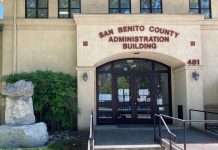Local water guru Jeff Cattaneo told the Free Lance there is “significantly less” flow headed into the Hollister treatment plant in 2015 than there was eight years ago shortly before a long-standing building moratorium ended.
“The amount of flow going into the City of Hollister treatment plant is significantly less now than 2007,” Cattaneo said. “All the water conservation stuff has helped reduce that. I think people are just more aware of using water now.”
It is a testament to the success of local water conservation efforts and perhaps also a reflection of stagnant residential growth until recently when development heated up. But it hasn’t stopped local officials from moving ahead on broad plans to spur improved water quality—along with a related program to provide reclaimed, or recycled, water to certain users such as farmers and golf courses.
Cattaneo, manager of the San Benito County Water District, gave an update to Hollister council members Monday on the reclaimed water endeavor, part of the broader $35 million Hollister Urban Area Water Project funded by rate hikes at local agencies and a $10 million contribution from the San Benito County Water District.
The recycled water portion of the project involves an $800,000 pipeline funded by the water district that will extend out to the Wright Road corridor. It will carry recycled water to agriculture uses along the route, while officials like Cattaneo hope to eventually expand the reclaimed use to other places such as golf courses and parks once the necessary infrastructure is in place.
Though the recycled portion is limited to the Wright Road corridor—with the location chosen based on a study—the belief is that the more recycled water gets used for agriculture, the less conventional water those farmers would need, conserving supplies in the local groundwater basin.
The water district is getting close to moving ahead on its recycled water program that has been in the works for years. The water district and city have a 30-year agreement in place with the prospect for 10-year extensions.
In the meantime, water agencies have used the Brigantino Park area entering Hollister on the west side and a site near the airport as spray fields for the recycled water. Officials about five years ago did pilot studies at Brigantino Park and another private property to confirm the safety of produce grown from the recycled water. All of the crops came back pathogen free, Cattaneo said.
While it’s pathogen free, the reclaimed water isn’t quite ready for full-time, permanent use because it’s too salty and, over the long run, would cause a serious salt buildup in local soil. With quality improvements coming at the front end of the water consumption cycle when people first use it, those improvements will extend to the back end and the recycled output as well, he said.
Cattaneo also talked to council members about prospects to use the reclaimed water for outdoor areas such as parks and golf courses. He explained that the water district is exploring agriculture first because there are greater efficiencies with infrastructure for ag use.










